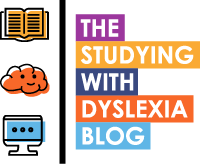In this article, I interviewed Bambi Gardiner about her experience of supporting her daughter Sophie through school and what strategies helped her daughter to effectively revise.
Read on to the end to take part in a competition to win £50 worth of dyslexia friendly revision guides from Oaka Books.
Welcome to the Studying With Dyslexia Blog, Bambi. Can you tell me a bit about Sophie’s challenges with dyslexia and what strategies didn’t seem to help her in terms of revision?
Sophie is severely dyslexic and has a slow processing speed, she also struggles with moving information from her short term to working memory. At school, much of the revision was done on the basis of 'copy out your notes' which is completely useless for a dyslexic as a) it takes forever and you don't get very far but, more importantly, and this is relevant for everyone, you are not retrieving any information from your memory to do it. If there is no 'active learning' taking place then nothing is going in! Being dyslexic her notes were also a complete mess, much of it wasn't completed and what was there was disorganised. Using standard revision books was a huge 'no-no'. They were simply too big with far too much text on the page, so much so that she just would not even open them. The other thing that was huge for her was us ignoring school saying things like 'you don't need to revise for this' or just giving a two week notice before a test or exam. She needs so much more time and I had to get teachers to give me their forward plans so we could get the work done at home. Finally, I learned quickly that I could not rely on what was happening in school. That's not a criticism, just a fact that they had 20 odd pupils in the class and mine fell outside of the 'norm' and I would always be the person who cared most about her outcomes so I couldn't 'leave it to the teachers'.
What materials did you try at the time and how did they impact on your daughter?
The biggest problem was that there were just no suitable revision materials designed for dyslexics . Companies have improved but they still continue to have the issues of too much text making their revision materials too big and off-putting.
What principles did you adhere to in order to help your daughter to effectively revise?
Bambi and Sophie Gardiner. Sophie is now studying at the University of Bath.
We started by breaking information down into bite-sized chunks, added little stick cartoon images created bullet point key facts. We then used characters to re-enact events for history stories and created Q&A cards for geography and science. We then turned these into games which were so important as she found the work hard enough so making it fun was essential. Repetition and interleaved learning is vital because if you just learn each topic individually and don't then go back over it for revision many times, you will think of it as an individual topic. However, in an exam you may need information from two or three topics in one question so interleaved learning through Q&A cards/games is great. We also always create a timetable working back from the date of the exam, looking at all the different topics she needed to revise, set aside time for full revision and then the Q&A sessions for each topic. That then dictated how early she needed to revise.
So I am sure that our readers would love to know what stage Sophie is at in her education now?
Sophie is now an undergraduate at the University of Bath studying Sports Performance.
Bambi, you mentioned earlier in this interview that companies are getting better at helping to provide more effective revision guides, but clearly you haven’t been satisfied by what is available because you started your own publishing company, Oaka Books to fill this gap. What has been the impact of your work at Oaka?
To answer this question, I would prefer my customers to help me with that so below I have provided quotes from a parent and a teacher. The Oaka materials are great for children working up to Key Stage 3 which them prepares them for their transition into Key Stage 4.
“Highly recommended - We have used several of the Oaka packs and find them fun and engaging. My son is a visual learner so enjoys the illustrations and layout. A great resource. Thankyou.”
“I tried this with a boy who was really struggling and was not engaged at all in his learning. He loved the whole thing and it totally changed our session together. Thank you!”





